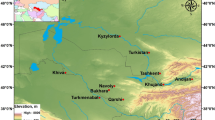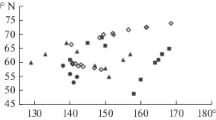Abstract
In this work, the bolide is studied as an atmospheric event causing significant release of meteoritic dust into the stratosphere. Ground-based pictures taken by eyewitnesses and images from the Japan geostationary satellite MTSAT-2 are used as a database. The analysis of the ground-based pictures allows the altitude of the main burst to be estimated as 22.9 ± 1.6 km. It is shown that the top of the cloud formed due to the main burst rose to 11 km for about 60–80 s due to convection, which provides an estimate of the maximum vertical velocity of 130–180 m/s. According to calculations, the upper part of the trail is affected by a strong wind drift and is located at an altitude of >53 km, in the mesosphere. The MTSAT-2 data show that the mesospheric part of the trail traveled southwestward, while the stratospheric part, northeastward, with velocities higher than 100 km/h.
Similar content being viewed by others
References
Borovicka, J., Spurny, P., and Shrbeny, L., Trajectory and orbit of the Chelyabinsk superbolide, Telegram no. 3423, Central Bureau for Astron. Telegrams, IAU, Feb. 23, 2013. CIMSS satellite blog. Satellite views of meteor vapor trail over Russia. http://cimss.ssec.wisc.edu/goes/blog/archives/date/2013/02/15. Cited Feb. 15, 2013.
Hunten, D.M., Turco, R.P., and Toon, O.B., Smoke and dust particles of meteoric origin in the mesosphere and stratosphere, J. Atmosph. Sci., 1980, vol. 37, pp. 1342–1357.
Kudinov, K. http://commons.wikimedia.org/wiki/File:Meteorit_Chelyabinsk_%2801%29.jpg. Cited Feb. 15, 2013.
Neely, R.R. III, English, J.M., Toon, O.B., et al., Implications of extinction due to meteoric smoke in the stratosphere, Geophys. Rev. Lett., 2011, vol. 38, p. L24808.
Rozen, D. and Ivanov, V.A., Stratospheric aerosol, in Aerozol’ i klimat (Aerosol and Climate), Kondrat’ev, K.Ya., Ed., Leningrad: Gidrometeoizdat, 1991, pp. 252–313.
Yomans, D., Fireball and bolide reports, 2013. http://neo.jpl.nasa.gov/fireballs/
Author information
Authors and Affiliations
Additional information
Original Russian Text © N.N. Gorkavyi, T.A. Taidakova, E.A. Provornikova, I.N. Gorkavyi, M.M. Akhmetvaleev, 2013, published in Astronomicheskii Vestnik, 2013, Vol. 47, No. 4, pp. 299–303.
Rights and permissions
About this article
Cite this article
Gorkavyi, N.N., Taidakova, T.A., Provornikova, E.A. et al. Aerosol plume after the Chelyabinsk bolide. Sol Syst Res 47, 275–279 (2013). https://doi.org/10.1134/S003809461304014X
Received:
Published:
Issue Date:
DOI: https://doi.org/10.1134/S003809461304014X




